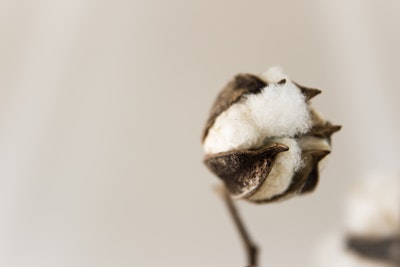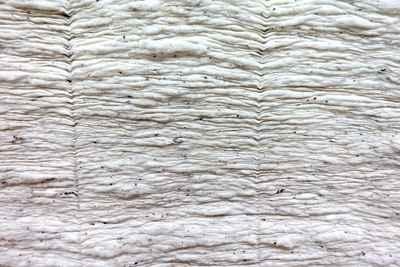How is Cotton Harvested?

Cotton is everywhere, in almost everything from socks to dish towels.
Where does cotton come from, and how is it harvested?
Cotton fields across the country start preparing for harvest between July and September.
The process takes several steps and produces cotton that will be sold around the world.
Preparing for Harvest
Planting takes place in the spring. The plants grow flower buds about two months later. Once the flowers open, they wither after three days and leave green football-shaped pods. These pods are called cotton bolls.
The boll then ripens and turns brown. Inside the bolls, cotton fibers grow and expand. Once the cotton inside the boll expands enough, the boll splits open, and the cotton pops out.
Farmers may use chemicals to assist in preparing the plants for harvest. Inclement weather is a significant concern for farmers since rain and snow can damage the cotton and lower the overall quality of the crop.
After coating the plants with the spray, the harvest aids help stimulate the plants to drop their leaves. Leaves can cause issues for the cotton on the plant. They can stain the cotton and degrade the quality of the harvest.
The harvesting aids also assist in drying the plant out. Drying makes the bolls easily separated by the harvester, thereby increasing the amount of viable yield.
Other sprays help the bolls open and mature quicker while also preserving the cotton quality as the harvest approaches.
The amount of chemicals used in these processes is relatively minimal since the farmers don’t want to damage any surrounding fields, not to mention how expensive the substances are.
Once the leaves have fallen off, and the bolls are open and dried out, the cotton is ready. It’s time for the harvest to begin.
Harvest
Farmers operate different types of harvesters depending on the cotton variety they grow.
Strippers harvest by pulling the entire boll, leaves, and branches off the plant. The bolls are collected from the plants by rollers that are equipped with bats and brushes.
The bolls are then knocked onto a conveyor. The cotton stripper then separates the “seed cotton” from the boll and other debris and directs it into a basket.
Cotton harvesting machinery uses spindles that pull the cotton out of the bolls and leave the plants mostly intact. The seed cotton is then pushed onto a conveyor and sent into the collection basket.
Once the collection baskets are filled, a few options are available to transport the seed cotton. A boll buggy can dump the seed cotton from the harvester basket to the boll buggy, which then drops the cotton off in a cotton module builder.
Cotton modules weigh around ten metric tons and are typically about 30 feet in length. The module is then covered with tarps or plastic sheets to keep excess moisture from building up in the fibers.
Another option is the round baler. This machine removes the need for a boll buggy and module builder. The baler is attached to the harvester and will drop round bales covered in plastic once they are the right size. The round baler streamlines the process.
Once the fields are harvested, the cotton is sent to the gin yard. Semis transport the modules or round bales on specialized trailers.
 Cotton Gin
Cotton Gin
The cotton gin processes the cotton to clean it. The process removes any remaining plant pieces and other waste while separating the cottonseed from the cotton fibers.
Cotton grows straight out of the seed, making the removal of cottonseeds necessary and unavoidable. There are several other impurities removed as well, including dust and any other debris from the field that was caught up in the harvester.
The fiber, or lint, is then pressed into bales that are then sent to a mill to be processed further.
The remaining cottonseed is processed into cottonseed oil or used as animal feed. Other uses for cottonseed vary.
Get Replacement Parts for Your Cotton Pickers
When the harvest is underway, and a part breaks, it can cause unexpected delays that may result in lost cotton. Maintaining machinery is critical to the success of the harvest.
By maintaining your cotton pickers and strippers regularly, you will be able to see any parts that have excessive wear. Replacing these parts is a must. We at Certi-Pik are here to get you those hard-to-find parts for your harvesters.
Most farmers are up to date on their service and maintenance schedules. The machines require regular maintenance, including thorough lubrication, servicing, and cleaning.
Removing all debris from the doffers and moistener pads is vital. If you find your harvester requiring replacement parts, it’s critical to use the correct part for your type of harvester.
Our team at Certi-Pik can find the right parts at excellent prices for you. We carry a wide range of aftermarket parts for your harvester needs. Reach out to us, and we will help you find those hard-to-find parts to get you back in the field.






